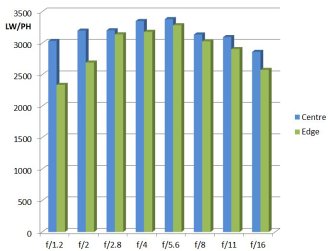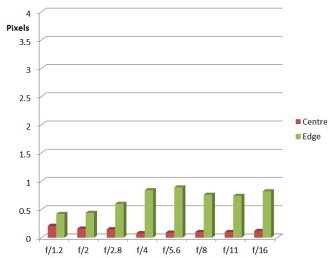Samyang Premium MF 85mm f/1.2 Review
Samyang Premium MF 85mm f/1.2 Performance
Sharpness is of a very high order, as befits a Premium lens range. Centrally, sharpness is excellent from f/1.2 right through to f/11. Diffraction takes the edge off slightly at f/16 but the results are still very good.
At the edges, we have a very good result at f/1.2 and f/2 and then excellent sharpness from f/2.8 through to f/11. This is still very good at f/16.
Peak performance is at f/5.6, and there is a very impressive evenness across the frame. In fact at middle apertures the edges match the central sharpness very closely.
How to read our charts
The blue column represents readings from the centre of the picture frame at the various apertures and the green is from the edges.The scale on the left side is an indication of actual image resolution as LW/PH and is described in detail above. The taller the column, the better the lens performance.
For this review, the lens was tested on a Canon EOS 5D Mark IV using Imatest.
CA (Chromatic Aberration) is well under control centrally and very acceptable at the edges. Most images show no signs of colour fringing. If deemed necessary, further reduction of CA can always be made in software.
How to read our charts
Chromatic aberration is the lens' inability to focus on the sensor or film all colours of visible light at the same point. Severe chromatic aberration gives a noticeable fringing or a halo effect around sharp edges within the picture. It can be cured in software.Apochromatic lenses have special lens elements (aspheric, extra-low dispersion etc) to minimize the problem, hence they usually cost more.
For this review, the lens was tested on a Canon EOS 5D Mark IV using Imatest.
There are no signs of flare under any circumstances, the coatings, design and excellent lens hood all playing their part.
As expected of a short telephoto, there is a small amount of pincushion distortion, measuring +0.571%. This is a commendably low amount and easily corrected further in software if required. It is unlikely that further correction will be necessary for most images.
Bokeh is the quality of the out of focus areas in an image. With a telephoto lens and its differential focusing the effect is enhanced anyway. The smoothness of the bokeh is excellent and the defocused backgrounds make the perfect backdrop to portraits in particular. Although the depth of field at f/1.2 is miniscule, and hence the focus point difficult to hit on the eyes, when it is achieved the results are beautiful.
Value For Money
The Samyang 85mm f/1.2 lens is priced at £899, and is available in Canon EF fit only. The only competition is from Canon themselves, with the EF 85mm f/1.2L II USM at £1649.
Given that there are no other 85mm f/1.2 optics the only other alternative is to look at 85mm f/1.4 lenses, of which there are plenty for most marques, but if that f/1.2 aperture is what we want then the Samyang offers a very keenly priced alternative to the Canon.
To put pricing in perspective, for Canon we have the Samyang 85mm f/1.4 IF MC (£259), Sigma 85mm f/1.4 DG HSM Art (£1199), Zeiss Milvus 85mm f/1.4 (£1379) and Zeiss Otus 85mm f/1.4 (£3299). These are also available for other marques.
To complete the picture, Nikon users have the choice of the above lenses, plus the Nikon AF-S 85mm f/1.4G at £1349. Sony users have the Sony 85mm f/1.4 ZA Planar T* (£1109) and, for the mirrorless cameras, the Sony FE 85mm f/1.4 G Master (£1649).
Even against the f/1.4 lenses the Samyang f/1.2 is looking very good value. For more options have a look at the Top 10 Best Samyang Lenses or the Top 27 Best Portrait Lenses.
Add your message
Please login here or if you've not registered, you can register here. Registering is safe, quick and free.
photodo Stats
428 MTF tests
74 in-depth photodo reviews
100+ users join each day
Help the lens community by reviewing or rating a lens today via our lens search
Latest Lens Reviews
- Chinon 28mm f/2.8 Vintage Lens Review
- Canon EF 70-200mm f/4L IS II USM Lens Review
- Samyang AF 85mm f/1.4 EF Review
- Sigma 70mm f/2.8 DG Macro Art Review
- Samyang AF 24mm f/2.8 FE Review
- Meike 50mm f/1.7 Review
- Tamron 70-210mm f/4 Di VC USD Review
- Lensbaby Burnside 35mm f/2.8 Review
- Asahi Super Takumar 50mm f/1.4 Review
- Asahi Super-Multi-Coated Takumar 135mm f/3.5 Review


